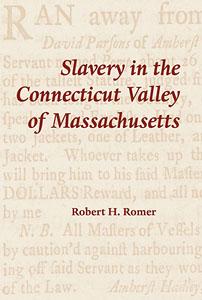Glass Houses
For many in the Bay State, slavery was not a moral issue—it was an accounting problem. Slavery in the Connecticut Valley of Massachusetts, by Professor Emeritus of Physics Robert Romer ’52 (Levellers Press)
Reviewed by Robert E. Weir
 |
[Nonfiction] If history is a quilt assembled from the scraps that survive, what does one do when there are only severed threads? Such is the challenge of scholars investigating the history of slavery, an institution that robbed its very subjects of their voices. As Robert Romer notes, studying the history of slavery in Massachusetts is complicated further by acts of “deliberate amnesia.” For example, an 1896 official town history of Amherst reproduced a 1759 tax evaluation list but omitted a column referencing slaves. When faced with problematic evidence, careful scholars refrain from imposing a cohesive narrative, build on what they have and investigate the worldview of the period under analysis. Romer’s book is a miscellany of incomplete stories, challenges to conventional wisdom and lessons to be learned.
The bulk of Romer’s material comes from a single place and time: Main Street, Deerfield, Mass., in 1752. Working from probate inventories, baptismal records, account books and other archival sources, Romer reconstructs a human geography showing that at least 8 percent of Main Street’s residents were slaves. It could have been more; whites routinely imposed the same slave names on individuals, thus making it difficult to distinguish one Titus, Cato or Jenny from another. What is clear, however, is that long-told stories that Bay State slavery was insignificant or benign are little more than guilt-assuaging myths. Deerfield slaves were whipped, sent to war, disfigured, rented and sold at will. Slavery was not a moral issue for Massachusetts owners; it was an accounting problem. One Deerfield owner was the Rev. Jonathan Ashley. Romer notes that Ashley did not own slaves to enhance his personal prestige or to uplift them—he expected slaves to make his farmlands profitable. Ashley was not unique; Romer compared Deerfield to surrounding Connecticut River Valley towns and assembled a list of two dozen Harvard- or Yale-educated slave-owning ministers, including New England icons Jonathan Edwards and John Russell.
When he can, Romer takes us inside slave lives. The threads tell us that Massachusetts slaves got married, built communities, attended church and resisted harsh masters. Romer’s snippets burst assumptions of all sorts. Illiterate slaves? Lucy Terry of Deerfield may have been America’s first black poet. Race revulsion? Lucy Billing and Elisabeth Chamberlain appeared in court with mixed-race children fathered by slaves. Moral reservations? Abijah Prince, a free black man, routinely rented slaves. The Rev. Stephen Williams of Longmeadow owned slaves, though he had been among the 109 captives from the 1704 Deerfield Raid forced to spend years in a Mohawk village in Canada.
The only constant in Romer’s miscellany is that New Englanders should confront their own past before passing judgment on the South. They could start by getting the facts straight. The oft-repeated story about ending slavery in Massachusetts is that its 1780 state Bill of Rights outlawed the practice and that the 1783 court case Walker v. Jennison finished the job. Not exactly. Many Bay State slaveholders took their “property” to Connecticut, New Hampshire or New York, where slavery remained part of the social landscape well into the 1840s. Even in Vermont, 16 slaves show up in the 1790 census. New England slavery was a dying institution by the 19th century, but—as Romer insists—before New Englanders celebrate their abolitionists, Underground Railroad activists and Fugitive Slave Act resistors, they should remember that the region’s slavery disappeared forever only after the passage of the 13th Amendment. Romer’s foray into microhistory is a poignant reminder that even frayed threads contain powerful truths.
Weir is a freelance journalist with a Ph.D. in history.